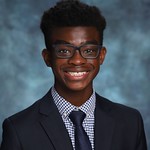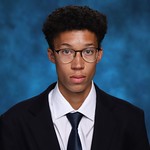STA News
Exploring Perspectives in Our Black Community
Members of the Upper School Black Affinity Group shared their experiences as young Black men at a recent assembly. They wanted to give a bit of insight into what it’s like being Black not only here at St. Albans but also in today’s world. While many of the Black students here share plenty of things in common, the students noted, they also have distinctive traits and contrasting cultures that make each of them unique.
 | Exploring Perspectives in Our Black Community: Introduction By David Adeleye ’25 With this month being Black History Month, it is the perfect time for us to reflect on the various Black cultural backgrounds at St. Albans. Here at St. Albans, we have a wide variety of Black voices, and it is important that they are heard here at this school. During today’s assembly, we hope to give everyone here a bit of an insight into what being Black is like, not only here at St. Albans, but also in today’s world. While many of the Black students here share plenty of things in common, we also have distinctive traits and contrasting cultures that make each of us unique from one another. There are countless stories to be, told and today we hope to share some of them with all of you. Through the sharing of these stories, we can grow as a community as we gain a better understanding of one another. By sharing these, we hope to display how interesting Black culture can be. | |
 | Exploring Perspectives in Our Black Community: Racial Stereotyping By Sebastian Waizenegger ’22 I’m not going sit here and lie to you and say that I myself experienced racism of any kind while living in the U.K., (probably because I was eight years old), but from afar, I saw racism. Socially, the perception of being Black is probably about a decade behind the U.S. in terms of how they are treated and depicted by your average person. Obviously in the U.S., there are many more, and much worse larger-scale incidents of racial prejudice. But your average person in the U.S. is much more socially aware. In the U.K., I witnessed several times in public spaces being stared at for being with my mom, because we have different skin tones, and several times, she was asked if she was me and my brother’s babysitter. My experience being mixed race at St. Albans is unique in some senses. In my seven years here, I have definitely heard things in settings in which people thought I wouldn’t get offended or get as angry about them saying certain things in my presence, most likely because of my lighter skin color or the simple fact that they might not even have known I was Black. At St. Albans, a predominately white institution, simply having that safety net of people who you can relate with and talk about your experiences with is really important. Click here to read more. | |
 | Exploring Perspectives in Our Black Community: Reaching Out By Kevin Glenn ’22 I still remember that first day vividly. I was waiting in line to shake Mr. Chandler’s hand when a classmate walked up to me, introduced himself, and then asked if I was Kevin Glenn. He stuck his hand out, so I shook it, a little confused. How did he know my name? I replied that I was, and he said he’d been looking for me because he saw my name on the lunch table sheet, and it said we’d be sitting together. Apparently, we had a few classes, too, including first period. I asked how he knew part of my schedule and where I was supposed to sit at lunch before I did. He told me about the bulletin board with the table assignments and pulled his phone out to show me how to navigate MySTA, which was called OnCampus at the time. We talked some more, and after greeting Mr. Chandler and walking through the doors, he showed me to my first class. A few of his friends were also in that class, but he sat next me and talked to me as if I’d been here as long as he had. I really appreciated that. That simple gesture did a lot to ease my fears, and I felt my pessimism turning to optimism, and this was literally five minutes before class had even started. I’ll spare you all the details of the rest of my day, but in short, he was my first friend at STA and introduced me to most of my current friends. Click here to read more. | |
 | Exploring Perspectives in Our Black Community: Culture & Blackness By Chase Williams ’22 In my life as a younger child, Black culture was shown to me predominately through my immediate family. I grew up knowing a Black woman, my mother; I knew a Black man, my father; Black boys, my older brothers; and a Black girl, my younger sister. Their culture, their traditions, their mannerisms, and their features were Black culture to me. As I grew older, however, and started to have more interactions with the world around me and see how it perceived Black culture and people like the ones in my family, I saw that there were many misconceptions contrary to what I knew and grew up seeing. Society seemed to portray Black women as incapable and irrational and angry, but my mother is strong, smart, and incredibly compassionate. Society paints Black men to be brute and irresponsible, but my father utilizes his mind in his work and actions and is very responsible, especially when it comes to his family. Society makes Black boys out to be wild and uncaring, but my brothers are polite and always made sure that their little brother was cared for. Society depicts Black girls as snarky and rude, my little sister is loving and vibrant. Click here to read more. | |
 | Exploring Perspectives in Our Black Community: Hair By Julian Matthews ’22 During my freshman year of high school, I enjoyed my new look, but as time went on, my hair continued to grow and grow and grow. At the end of my freshman year, I had accumulated a large amount of hair, but it was just on my head doing absolutely nothing. Eventually my mother came to my aid and asked me if I wanted her to do my hair. At first I was a little confused, I remembered my mom used to do my sister’s hair when we were both still in middle school, but I didn’t think it was a normal thing for a guy’s hair to be “done.” At first I told her I was good, since I didn’t want to look like a middle school girl. But she told me either she did my hair, or I had to cut it all off. I definitely didn’t want to lose all the hair I worked so hard to grow. So I let my mom do her bidding and style my hair. After about two and a half hours, I was presented with the hairstyle I am rocking right now: the two-strand twists. Turned out that I didn’t look like a middle school girl; I looked kind of clean. Returning to school, I was met with some mixed reviews: Some people liked it; some people said my hairstyle was a little weird; my father took a picture of me in a bonnet and sent it to my whole family, and they all laughed at me; and one person (I know who you are, and I will not forget this) said that my hair looked like twirled up pieces of poop. Although I did not appreciate this comment, I kept it moving and as time went on I eventually began to see other people style their hair exactly like mine. By the end of my sophomore year, it was completely normal for people to be rocking braids, twists, or cornrows. I’m not trying to say I started something, but I don’t know who was doing it before me! Click here to read more. | |
 | Exploring Perspectives in Our Black Community: Racial Justice By Tendai Ball ’22 As You Sow is a nonprofit foundation chartered to promote corporate social responsibility through shareholder advocacy, coalition building, and legal strategies. Tendai Ball ’22 and Julian Matthews ’22 were hired as research associates with the organization, and Tendai presented some of their research during the assembly. You can read more about this racial justice research, including resolutions, data visualization, and social justice initiatives, on the As You Sow website. |
Located in Washington D.C., St. Albans School is a private, all boys day and boarding school. For more than a century, St. Albans has offered a distinctive educational experience for young men in grades 4 through 12. While our students reach exceptional academic goals and exhibit first-rate athletic and artistic achievements, as an Episcopal school we place equal emphasis upon moral and spiritual education.




